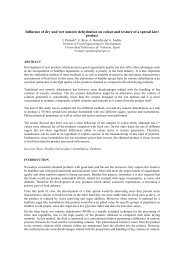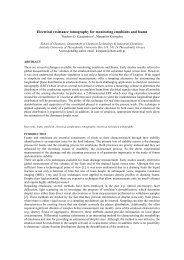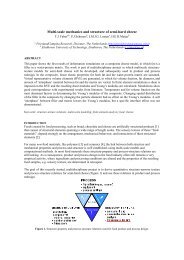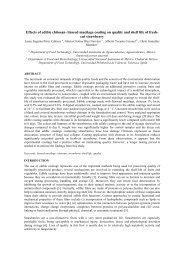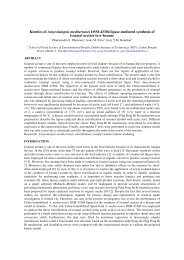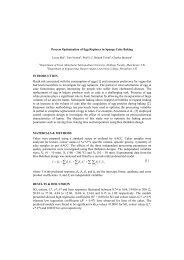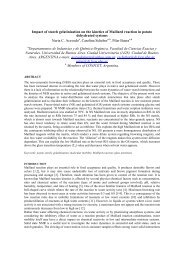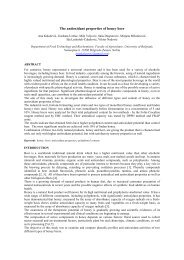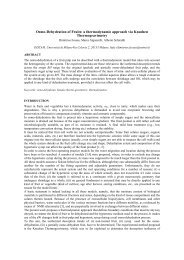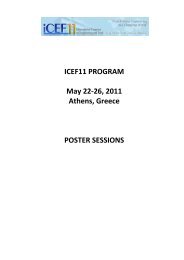Functional properties of foods. Database and model prediction
Functional properties of foods. Database and model prediction
Functional properties of foods. Database and model prediction
Create successful ePaper yourself
Turn your PDF publications into a flip-book with our unique Google optimized e-Paper software.
<strong>Functional</strong> Properties <strong>of</strong> Foods. <strong>Database</strong> <strong>and</strong> Model Prediction<br />
Nikolaos A. Oikonomou a , Magda Krokida b<br />
a Department <strong>of</strong> Chemical Engineering, National Technical University <strong>of</strong> Athens, Athens, Greece<br />
(nikosoik@central.ntua.gr)<br />
b Department <strong>of</strong> Chemical Engineering, National Technical University <strong>of</strong> Athens, Athens, Greece<br />
(mkrok@chemeng.ntua.gr)<br />
ABSTRACT<br />
A food system is characterized by several physicochemical <strong>properties</strong>. Some <strong>of</strong> those physicochemical<br />
<strong>properties</strong> affecting the food system during preparation, processing, storage <strong>and</strong> consumption are defined<br />
functional <strong>properties</strong>. A wide range <strong>of</strong> functional <strong>properties</strong> are delivered mainly by proteins, due to their<br />
structural characteristics <strong>and</strong> amphiphilic nature. Additionally, protein functionality is affected by extrinsic<br />
factors such as temperature, pH, ionic strength, <strong>and</strong> interaction with other components. The novelty <strong>of</strong> the<br />
present study was the collection <strong>of</strong> experiment data in a database from the available scientific journals,<br />
regarding the values <strong>of</strong> water absorption index, water solubility index, protein dispersibility index, nitrogen<br />
solubility index, gluten index <strong>and</strong> wet gluten <strong>and</strong> secondly the investigation <strong>of</strong> statistical <strong>model</strong>s for optimum<br />
correlation <strong>of</strong> the retrieved data. The published data was then organized based on the experimental factors.<br />
For the water absorption index <strong>and</strong> water solubility the main experimental factors were the leading extrusion<br />
parameters such as die temperature, screw speed, feed moisture content. The extrinsic factors concerning the<br />
protein dispersibility index <strong>and</strong> nitrogen solubility index was the pH, the amount <strong>of</strong> heat treatment, the total<br />
time <strong>of</strong> treatment <strong>and</strong> the level <strong>of</strong> enzymatic hydrolysis. Finally, for gluten index <strong>and</strong> wet gluten the<br />
correlated factors were the wheat genotype, fertilization level, crop location, <strong>and</strong> the exist subunits <strong>of</strong><br />
genotype. Furthermore, mathematical <strong>model</strong>s were developed to describe the relationship between functional<br />
variables <strong>and</strong> the main experimental factors. The statistical <strong>model</strong>s fit the experimental data as closely as the<br />
experimental variance (literature noise) would allow. The estimation <strong>of</strong> parameters <strong>of</strong> power low regression<br />
<strong>model</strong>s was conducted by the Levenberg–Marquardt algorithm <strong>and</strong> the regression diagnostic shows a good fit<br />
<strong>of</strong> datasets to functional <strong>properties</strong>. The investigation <strong>of</strong> food functional <strong>properties</strong> is <strong>of</strong> great importance for<br />
food industry as they affect the quality <strong>and</strong> acceptance <strong>of</strong> the final product.<br />
Keywords: Extrusion; Cereals; Soybean products; <strong>Database</strong><br />
INTRODUCTION<br />
<strong>Functional</strong>ity is a term used to describe those characteristics <strong>of</strong> a food that have been correlated to quality<br />
attributes identified by the human senses. Proteins play important roles in the functional <strong>properties</strong> <strong>of</strong> many<br />
<strong>foods</strong>, <strong>and</strong> thus contribute to the quality <strong>and</strong> sensory attributes <strong>of</strong> many food products. Protein functional<br />
<strong>properties</strong> have traditionally been defined as physical or chemical <strong>properties</strong> <strong>of</strong> proteins that affect their<br />
behaviour in food systems during preparation, processing, storage, <strong>and</strong> consumption [1,2,3,4,5]. The novelty<br />
<strong>of</strong> the present study was firstly the investigation <strong>and</strong> proper classification <strong>of</strong> the effect <strong>of</strong> various parameters<br />
on six typical functional <strong>properties</strong> such as water absorption index (WAI), water solubility index (WSI),<br />
protein dispersibility index (PDI), nitrogen solubility index (NSI), gluten index (GI) <strong>and</strong> wet gluten (WG) <strong>of</strong><br />
several food products <strong>and</strong> secondly the investigation <strong>of</strong> statistical <strong>model</strong>s for optimum correlation based on<br />
the retrieved data.<br />
MATERIALS & METHODS<br />
For <strong>model</strong> purposes an extensive literature search was contacted through the most popular food engineering<br />
<strong>and</strong> food science journals <strong>of</strong> recent years. The compiled data, approximately 10,000 values, <strong>of</strong> the previous<br />
functional <strong>properties</strong> were organized into a database developed in Micros<strong>of</strong>t Excel 2003.<br />
Extrusion is a technological process, commonly used in the field <strong>of</strong> the human <strong>and</strong> animal feed industry,<br />
applied successively on a broad spectrum <strong>of</strong> commercially manufactured products. It is observed that WAI<br />
<strong>and</strong> WSI are related to the extrusion process variables such as extruder type, die temperature, feed moisture
content, feed rate, screw speed, screw configuration. Other affecting factors may include raw material<br />
formulation, pre-processing treatments, initial particle size <strong>of</strong> milled materials, <strong>and</strong> the milling procedure. A<br />
preliminary statistical investigation shows that we have a strong relationship between WAI or WSI <strong>and</strong> 4<br />
independent variables such as die temperature, feed moisture content <strong>of</strong> food product in wet base %, screw<br />
speed <strong>of</strong> extruder <strong>and</strong> blend level% mainly for starchy <strong>and</strong> proteinaceous extruded food products. It is found<br />
from the <strong>model</strong>ling exercise that using a <strong>model</strong>, which considers power law dependency <strong>of</strong> all independent<br />
variables, provides the best performance in the <strong>model</strong>:<br />
WAI or WSI<br />
<br />
a <br />
<br />
T<br />
T o<br />
where WAI: water absorption index (dimensionless), WSI: water solubility index (%), T: die temperature <strong>of</strong><br />
extruder ( o C), X: feed moisture content <strong>of</strong> food product in wet base %, S: screw speed <strong>of</strong> extruder (rpm), M:<br />
mixture <strong>of</strong> blend %, variables with subscripts: reference steady average values <strong>of</strong> independent variables,<br />
a,b,c,d,e: dimensionless adjustment parameters.<br />
Similarly, concerning the property <strong>of</strong> PDI the intended <strong>model</strong> is:<br />
b<br />
PDI a <br />
T <br />
<br />
<br />
T <br />
o <br />
t<br />
t<br />
where PDI: protein dispersibility index (%), T: is the temperature <strong>of</strong> the product which was exposed during<br />
preparation ( o C), t: is the corresponding residence time (10 3 *s), variables with subscripts: reference steady<br />
average values <strong>of</strong> independent variables, a,b,c: dimensionless adjustment parameters.<br />
The parameter estimation was performed by the Levenberg–Marquardt (LM) algorithm. The LM algorithm is<br />
an iterative technique that locates the minimum <strong>of</strong> a multivariate function that is expressed as the sum <strong>of</strong><br />
squares <strong>of</strong> nonlinear real-valued functions. The s<strong>of</strong>tware package Stargraphics Centurion v. XV (Manugistics<br />
Inc. Rockville, MD, USA) was used for the nonlinear regression analysis.<br />
RESULTS & DISCUSSION<br />
b c<br />
X <br />
<br />
<br />
X<br />
<br />
o <br />
c<br />
<br />
<br />
o <br />
Table 1 presents, in a compact form, the main information concerning the examinee <strong>properties</strong>. The<br />
minimum, maximum, average values <strong>and</strong> the st<strong>and</strong>ard deviation for each <strong>of</strong> six <strong>properties</strong> are presented in the<br />
first four columns. The main food systems <strong>and</strong> the factors which altered the value <strong>of</strong> <strong>properties</strong> are presented<br />
in the fifth <strong>and</strong> sixth columns respectively. Finally, the total number <strong>of</strong> experimental data which was<br />
retrieved is presented in the final column.<br />
Table 1. Data compiled from literature about examinee functional <strong>properties</strong> used in statistical analysis<br />
Property MIN MAX AVG SD a Food System Main Factor N b<br />
WAI 0.3 14.4 4.8 1.9 Corn, Wheat,<br />
Rice Flours<br />
WSI 0.2 94.8 22.4 15.4 Corn, Wheat,<br />
Rice Flours<br />
PDI 1.3 100.0 42.0 42.0 Soybean<br />
Products<br />
NSI 2.5 94.0 40.7 19.4 Soybean<br />
Products<br />
Extrusion parameters,<br />
blends<br />
Extrusion parameters,<br />
blends<br />
pH, Heat, Enzymatic<br />
Hydrolysis<br />
pH, Heat, Enzymatic<br />
Hydrolysis<br />
GI 1.0 100.0 71.0 25.1 Wheat Products Genotype, Fertilization,<br />
Location, Subunits<br />
WG 0.2 60.9 29.6 9.2 Wheat Products Genotype, Fertilization,<br />
Location, Subunits<br />
a St<strong>and</strong>ard Deviation; b Number <strong>of</strong> retrieved data<br />
S<br />
S o<br />
d e<br />
M<br />
<br />
<br />
M<br />
<br />
o <br />
Due to the large number <strong>of</strong> replicates, a fundamental prerequisite for the least squares fitting <strong>of</strong> the <strong>model</strong>s to<br />
the corresponding data sets is equal variance <strong>of</strong> the different observations. The results <strong>of</strong> these tests show that<br />
the variance was almost steady. The results <strong>of</strong> the nonlinear regression analysis <strong>of</strong> fitting the equation 1 to the<br />
experimental points are shown in Table 2. In this table the st<strong>and</strong>ard experimental error <strong>and</strong> the st<strong>and</strong>ard<br />
deviation between experimental <strong>and</strong> calculated values are also presented. In most cases the values <strong>of</strong> the<br />
1268<br />
1083<br />
1067<br />
780<br />
3400<br />
2354<br />
(1)<br />
(2)
st<strong>and</strong>ard experimental error are slightly smaller (or slightly bigger in the cases <strong>of</strong> corn starch:WPC <strong>and</strong> rice<br />
starch:SPI) than the values <strong>of</strong> the st<strong>and</strong>ard deviation between experimental <strong>and</strong> calculated values indicating<br />
that the <strong>model</strong> (Eqn. 1) is satisfactory in predicting the WAI <strong>of</strong> products. In the cases <strong>of</strong> wheat, wheat:DDG<br />
<strong>and</strong> potato:DDG the difference in the values was slightly bigger than that in the above cases showing that<br />
there is an adequate fit to the equation 1.<br />
Table 2. St<strong>and</strong>ard experimental error (Se), st<strong>and</strong>ard deviation between experimental <strong>and</strong> calculated values (Sr) <strong>and</strong> the<br />
parameters <strong>of</strong> the <strong>model</strong> for the WAI <strong>and</strong> WSI <strong>prediction</strong> respectively<br />
Property Food System Se Sr a b c d e<br />
WAI Barley cv. 0.60 1.29 4.62 -0.69 0.44 0.86 0<br />
Corn 0.42 0.69 5.23 0.07 0.16 0.35 0<br />
Oat 0.24 0.55 2.26 -0.68 -0.14 -0.06 0<br />
Rice cv. 1.12 1.21 5.97 0.09 0.60 0.01 0<br />
Wheat 0.26 1.88 4.63 -1.07 -0.46 0.46 0<br />
Beans & Chickpeas cv. 0.42 1.51 4.07 0.11 0.49 0.05 0<br />
Starch 1.08 3.06 7.54 1.23 0.91 -0.06 0<br />
Blends<br />
Corn : DDG a 0.40 0.74 0.04 0.11 -0.06 -7.46 -0.17<br />
Corn : Lentil 0.28 0.53 4.39 0.28 0.15 1.00 -0.00<br />
Rice : DDG 0.41 1.21 7.54 0.17 0.32 1.00 -0.08<br />
Wheat : DDG 0.40 1.78 4.07 -0.60 -0.13 0.34 -0.12<br />
Corn starch : WPC b 1.55 1.21 5.37 0.30 0.54 0.14 -0.08<br />
Rice starch : SPI c 1.02 0.51 19.40 0.15 -0.33 1.00 -0.29<br />
Potato : DDG 0.53 2.07 9.40 0.03 0.19 1.00 -0.12<br />
WSI Corn 5.96 11.99 19.76 -0.16 -0.34 -0.20 0<br />
Oat 0.18 1.20 6.24 -0.08 -0.51 -0.07 0<br />
Rice cv. 2.53 18.70 23.17 1.36 0.10 -0.04 0<br />
Wheat 3.34 9.96 10.42 2.57 0.02 1.45 0<br />
Beans & Chickpeas cv. 2.96 16.58 33.98 -1.48 1.12 0.26 0<br />
Starch 7.91 27.30 27.80 0.70 -0.41 -1.09 0<br />
Blends<br />
Corn : Lentil 6.23 7.57 12.76 0.52 -0.72 1.00 -0.11<br />
Corn starch : WPC d 10.00 15.48 27.18 -0.20 0.02 0.60 -0.11<br />
a Dried Distillers Grains from corn & wheat; b Whey protein concentrate; c Soy protein isolate; d Whey protein concentrate; cv: cultivar<br />
The plot, which relate the WAI (left figure) with die temperature <strong>of</strong> extruded products at X=15 % <strong>and</strong> S=180<br />
rpm are presented in figure 1. The various dots shapes represent the experimental values <strong>of</strong> materials, while<br />
the lines are calculated <strong>model</strong> values. Increase in die temperature does not have a consistent effect on<br />
experimental <strong>and</strong> predicted WAI for all raw materials examined. In the case <strong>of</strong> WSI (right figure) at X=15 %<br />
<strong>and</strong> S=200 rpm we conclude that there is not a general tendency for the various extruded materials with<br />
respect to the die temperature. Figure 2 presents typical chart <strong>of</strong> the st<strong>and</strong>ard experimental error (Se) <strong>and</strong> lack<br />
<strong>of</strong> fit (Sr) as a function <strong>of</strong> the number <strong>of</strong> parameters for WAI <strong>model</strong> in the case <strong>of</strong> rice.<br />
The confidence intervals (=0.05) for parameters <strong>of</strong> food products (data not shown), for WAI <strong>and</strong> WSI show<br />
that all the calculated parameters are required in the equation 1. The products such as wheat, beans,<br />
wheat:DDG with two or more parameters having 0 within the range <strong>of</strong> their confidence intervals are also<br />
those products where the differences in the values <strong>of</strong> Se <strong>and</strong> Sr was great. In these cases the number <strong>of</strong><br />
parameters for accurate <strong>prediction</strong> <strong>of</strong> the <strong>model</strong> may be smaller.<br />
The values <strong>of</strong> Se, Sr <strong>and</strong> parameters for PDI (Eqn. 2), obtained by curve fitting using lack <strong>of</strong> fit regression<br />
diagnostic with Levenberg–Marquardt algorithm are presented in Table 3, showing that the performance <strong>of</strong><br />
the proposed regression <strong>model</strong>, was satisfactory for the case <strong>of</strong> beans <strong>and</strong> canola meal. The results presented<br />
in Table 3 suggest that, for soy flour <strong>and</strong> soybean components, a power low nonlinear relationship between<br />
PDI <strong>and</strong> the two predictor variables (exposing temperature, corresponding residence time) is moderate; a
St<strong>and</strong>ard Deviation<br />
WAI .<br />
different relationship concerning more predictor variables is more appropriate. In general, the agreement<br />
between the experimental data <strong>and</strong> the estimated values is reasonably good.<br />
10<br />
Χ = 20 % (wb) S = 180 (rpm)<br />
9<br />
Starch<br />
8<br />
7<br />
Rice<br />
6<br />
5<br />
Corn<br />
Beans<br />
4<br />
3<br />
Barley<br />
Wheat<br />
2<br />
1<br />
Oat<br />
0<br />
80 110 140 170 200 230 260<br />
Die Temperature ( o C)<br />
WSI % .<br />
50<br />
Χ = 15 % (wb) S = 200 (rpm)<br />
45<br />
40<br />
35<br />
Beans<br />
Rice<br />
30<br />
Starch<br />
25<br />
20<br />
15<br />
10<br />
5<br />
0<br />
Wheat<br />
Corn<br />
Oat<br />
80 110 140 170 200 230 260<br />
Die Temperature ( o C)<br />
Figure 1. Effect <strong>of</strong> die temperature ( o C) on WAI (left) <strong>and</strong> WSI (right) for barley (▲), corn (●), oat (■), rice (x), wheat<br />
(◊), beans (○) <strong>and</strong> starch (□). Lines are calculated <strong>model</strong> values using parameters given in Table 2<br />
16<br />
12<br />
8<br />
Lack <strong>of</strong> fit<br />
4<br />
0<br />
Experimental<br />
error<br />
0 1 2 3 4 5<br />
Number <strong>of</strong> Parameters<br />
Figure 2. The st<strong>and</strong>ard experimental error (Se) <strong>and</strong> lack <strong>of</strong> fit (Sr) as a<br />
function <strong>of</strong> the number <strong>of</strong> parameters for WAI <strong>model</strong>; case <strong>of</strong> rice<br />
Table 3. St<strong>and</strong>ard experimental error (Se), st<strong>and</strong>ard deviation between experimental <strong>and</strong><br />
calculated values (Sr) <strong>and</strong> the parameters <strong>of</strong> the <strong>model</strong> for the PDI <strong>prediction</strong><br />
Food System Se Sr a b c<br />
Beans (P. vulgaris L.) meal 2.83 3.23 16.58 -0.98 -0.05<br />
Canola meal 1.55 1.98 21.57 -2.08 0.11<br />
Soy flour 3.34 14.45 16.22 -3.26 -0.10<br />
Soybean 0.62 3.18 27.08 -0.01 -0.06<br />
The variety <strong>of</strong> experimental PDI values ranges from 6.2 to 96.8 while, PDI predicted vary from 6.6 to 46.8<br />
for all products. The smaller range <strong>of</strong> predicted values compared to experimental values may be explained by<br />
the low ability <strong>of</strong> the <strong>model</strong> to predict accurate values mainly at high values <strong>of</strong> independent variables. The<br />
scatter plot, which relates the PDI with residence time <strong>of</strong> products at three different temperatures for beans
100<br />
110<br />
120<br />
130<br />
140<br />
PDI %<br />
PDI %<br />
PDI %<br />
meal is presented in figure 3 (left). Incremental increase in residence time does not have a consistent effect<br />
on experimental <strong>and</strong> predicted values <strong>of</strong> PDI for all examined products. Figure 3 (right) presents the scatter<br />
plot <strong>of</strong> PDI versus temperature at three different residence times for beans meal. In general, an increase in<br />
temperature leads to a decrease <strong>of</strong> PDI value, for all products. A possible explanation for this situation is that<br />
when the protein is heated rapidly, denatures. The quaternary or tertiary structure is destroyed <strong>and</strong> the protein<br />
molecules break up into several subunits, <strong>of</strong> which some slowly form a soluble <strong>and</strong> later on insoluble<br />
aggregate, whereas the rest remains in solution. Simultaneously other factors such as pH, salt content <strong>and</strong><br />
additives concentration can affect the protein solubility; however we don't take them into consideration for<br />
practical reasons.<br />
25<br />
23<br />
20<br />
18<br />
15<br />
13<br />
10<br />
0 1 2 3 4 5 6 7<br />
t x10^3 (s)<br />
T=102<br />
T=113<br />
T=136<br />
Figure 3. The graphical correlation between experimental (dots) <strong>and</strong> calculated (lines) values <strong>of</strong> PDI versus residence<br />
time (left) <strong>and</strong> temperature (right) for beans meal<br />
The effect <strong>of</strong> temperature <strong>and</strong> residence time on predicted PDI values for the beans meal is presented in<br />
figure 4. The minimum <strong>and</strong> maximum values <strong>of</strong> the independent variables are based on the corresponding<br />
experimental values. At high temperatures, the PDI <strong>of</strong> all products decreased considerably with increasing<br />
residence time, while at high residence times, the decrease in temperature resulted in only a slight decrease in<br />
PDI (Fig. 3).<br />
25<br />
23<br />
20<br />
18<br />
15<br />
13<br />
10<br />
100 105 110 115 120 125 130 135 140<br />
T ( o C)<br />
t=0.09<br />
t=3.65<br />
t=7.2<br />
24<br />
22<br />
20<br />
18<br />
16<br />
14<br />
12<br />
10<br />
0.09<br />
2 468<br />
t x10^3<br />
(s)<br />
CONCLUSION<br />
T ( o C)<br />
Figure 4. Contour plots showing the effect <strong>of</strong> temperature <strong>and</strong><br />
residence time on calculated PDI values for beans meal<br />
The present study proposes a mathematical <strong>model</strong> that investigates the effects <strong>of</strong> the main extrusion variables<br />
on the WAI <strong>and</strong> WSI <strong>properties</strong> for some food products. The <strong>model</strong> is fitted to literature data <strong>and</strong> the <strong>model</strong><br />
parameters were estimated for every category <strong>of</strong> food products. The method used for curve fitting was a<br />
nonlinear regression that was based on the Levenberg–Marquardt algorithm. In most cases, the <strong>model</strong>ling<br />
showed that the power law equation is fitted satisfactory to the available experimental values. Furthermore,<br />
<strong>model</strong>ling <strong>of</strong> a solubility index (PDI) for food products which contain protein or starch showed that power
low equations is fitted adequately to the available experimental values, which allows theoretical <strong>prediction</strong> so<br />
that important information can be withdrawn without experimental procedures.<br />
REFERENCES<br />
[1] Maroulis, Z.B.; Saravacos, G.D. 2007. Food Plant Economics. CRC Press: Boca Raton, pp.70-99.<br />
[2] Maroulis, Z.B.; Saravacos, G.D. 2003. Food Process Design. Marcel Dekker: USA, pp. 2-13.<br />
[3] Oikonomou N.A. & Krokida M. 2011. Literature Data Compilation <strong>of</strong> WAI <strong>and</strong> WSI <strong>of</strong> Extrudate Food Products.<br />
International Journal <strong>of</strong> Food Properties, 14(1), 199-240.<br />
[4] Oikonomou N.A. & Krokida M. 2011. Water Absorption Index <strong>and</strong> Water Solubility Index Prediction for Extruded<br />
Food Products. International Journal <strong>of</strong> Food Properties, In Press.<br />
[5] Oikonomou N.A. & Krokida M. 2011. Protein Dispersibility Index: Data Compilation from Published Research for<br />
1065 Foods Classified into Seven Product Categories. International Journal <strong>of</strong> Food Science <strong>and</strong> Technology,<br />
Submitted.



